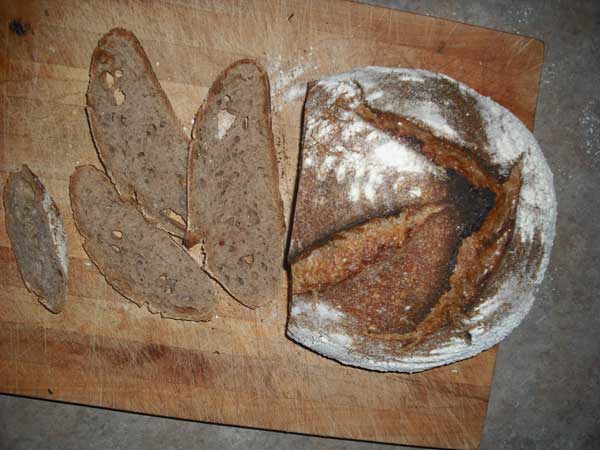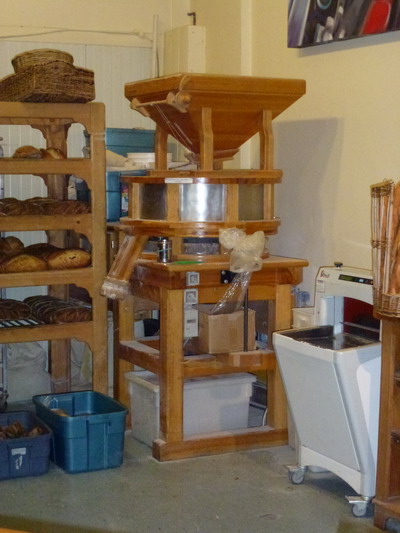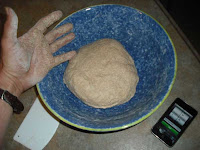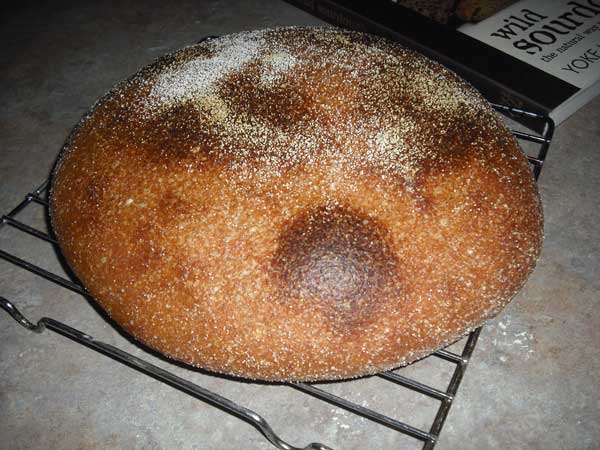 |
| A couple of early January loaves |
What have I been up to? Sure, I've been baking bread in January. What's missing is the blogging about it, as I use January as a time of reflection (
don't I want to do something more important with my time?) and work on other things. But am I a junkie for the bread, or for the blogging about it? A bit of both, actually.
I've been reading a very interesting book on addiction: "
In the Realm of Hungry Ghosts" by Gabor Maté, M.D. Mate works in Vancouver with many junkies who are addicted to heroin, cocaine and ecstasy, and who pay their way with theft and prostitution. And inevitably, I'm thinking about my own addiction to bread and its exorphins.
Maté writes,
"Activities such as eating or sexual contact also promote the presence of dopamine in the synaptic space. Dr. Richard Rawson, Associate Director of UCLA's Integrated Substance Abuse Program, reports that food seeking can increase brain dopamine levels in some key brain centres by 50 per cent. Sexual arousal will do so by a factor of 100 per cent, as will nicotine and alcohol. But none of these can compete with cocaine, which more than triples dopamine levels. Yet cocaine is a miser compared with crystal meth, or "speed," whose dopamine-enhancing effect is an astounding 1200 per cent. It's easy to see why the crystal-meth-addicted woman Carol spoke of the drug's effect as an "orgasm without sex." After repeated crystal meth use the number of dopamine receptors in crucial brain circuits will be reduced, just as with cocaine."
So with bread I'm getting that 50% from eating and food seeking, plus whatever the exorphins give me. Writing about it also feeds the addiction.
 |
| Standard fare: a 25% Rye with Whole Wheat |
I got a couple of real bannetons for the holiday gift-giving season. The first time I tried it out I had a very wet dough and it all sagged.
I think I was using some ratio of millet here. (I found my notes after posting this. This bread was made with 20% Red Fife, 30% Teff and 50% Whole wheat, at 78% hydration. The problem was the teff had no gluten, so the dough was too hydrated; and the red fife makes everything stale quicker.) The loaves were too ugly to give to my friend and I ate both loaves myself. I remember that they were mostly stale, but that is because they were just not nice and it took me a long time to get through them.
Before leaving on holidays I baked 4 loaves, one to eat, one to give away, one to take with me (!) and one for the freezer for when I got back. I keep trying different ways of kneading it to get to the point where I don't have these wide irregular holes. While they are always fun to explore as you cut into the loaf, they just don't hold jelly.
A trip away
I've just returned from Vancouver Island B.C., an
off-season (cheap!) tourist vacation for me, a working trip for my wife. I spent my time wandering around the various bookstores and visiting some wonderful bakeries. I actually took a loaf of my own bread with me in a suitcase, carefully nestled between clean socks and underwear, just in case I couldn't find any loaves to meet my bread-snob levels of discernment. However, my bread didn't get eaten. It got ropey after a week in the island dampness, and I left it behind in our bed-and-breakfast the day we left. I'm happy to report that many bakeries in Victoria and Nanaimo were wonderful.
The Mainland: Vancouver
We took the ferry to the mainland one day, and while my wife did some work, I wandered along Quebec street towards the mountains. I walked through the lovely
Sun Yat Sen Gardens in Chinatown, then continued on to see if I could catch a glimpse of the harbour. Suddenly I found myself in Vancouver's east end, actually walking past Hastings street, near where Maté works with his drug addicts. I was accosted by a pimp, and decided that I really ought not to be there. I didn't see any bakeries here anyway.
I did find one used bookstore, much further south, and got a bread book there.
You know you are an exorphin junkie when you'd rather find a bakery than have sex.
Nanaimo
I'll mention a couple of my favourites. In Nanaimo, the
Nanaimo Bakery & Confectionary has some really nice German style breads. Their brötschen are pretty good too, but of course, they use some all-purpose or bread flours. But I especially liked what they call a "full grain" bread (no sign identifies it as a Vollkorn loaf, so I assume they are trying to appeal to English speakers rather than identify themselves as catering merely to Germans). It had a dark, soft crumb and was full of wholegrain taste, sliced thinly like a pumpernickel but without the pumpernickel bitterness. I can't remember now whether they used sourdough. We stopped for a bite there; they have a pretty simple lunch fare, but it is extremely nourishing. Highly recommended if you are in Nanaimo.
Nearby in Nanaimo, also on Bowen street, and pretty darn good too is the
Columbia bakery. We stopped in here and had their pretzels and Bienenstich (not as good as my mother-in-law's though). Worth the trip for those alone. I had my eye on their rye bread, but decided I wouldn't get through it on this trip. Watch for the pretzel-shaped door handle.
Victoria
I'll mention a couple of bakeries in Victoria, too. While visiting the insanely overstocked
Russell books on Fort Street (I love it!), I passed a couple of bakeshops. The
Dutch Bakery is more of a confectionary, I'll say. Give it a pass and walk on to the smaller bread shop next door,
Rheinland Bakery. I'd even go so far as to say, if you want a pastry, try Rheinland's first. They have some sourdough loaves, and although they use all purpose or bread flour in most of their loaves (even their wholegrain breads), they do a good job. When I was there, the slicer was busted, but I expect that will be fixed soon. I bought a dark rye here and it was okay. Nice and helpful staff.
But by far and away the best bakeshop I found while in Victoria was the
WildFire Organic Bakery & Cafe.
 |
| Early morning in Victoria at Wild Fire Bakery |
 |
| Their mill where they grind their own local-as-possible organic grains |
 |
| The double woodfire oven dominates the room |
|
 |
| A few representative loaves for retail customers. Note the community's art on the walls. |
|
What separates it from the rest of the crowd is their devotion to organically grown, as-local-as-possible grains which they mill right there -- their use of wild yeast -- and of course, their huge wood fire oven. On top of all that, this bake shop was built on the site of an old community centre, and it retains a lot of that community atmosphere. It frankly doesn't get any better than this, although the staff was a bit stunned by my enthusiasm and interest.
The original baker/owner, Erika Heyrman wasn't there when we arrived. From brochures, we learned that she started baking whole grain, wholesome wild-yeast bread from the freshest ingredients and selling it from her driveway. Later she had an opportunity to put a community-built woodfired oven into this old community building.
Good bread makes a good community.
Oh, and they make good coffee and pastries -- many of these made with Levain.
These pastries are what Tartine pastries should have been.
They were just baking the 100% rye while I was there, so unfortunately I didn't taste their rye. But I did try their whole wheat, and their multigrain loaves. I can't recommend it more highly. Sure it is expensive. Support this bread. You won't find better unless you bake it yourself, and even then, you'd have to find fresher ingredients.
Bread Books
Now let's talk about books. I thought I'd learned my lesson about books: they are cheaper to buy online and have shipped, these days, than they are to buy in a distant land while on vacation. Then, you have to pay extra for the weight of your luggage when you try to stuff them in a suitcase. Books are heavy! But when you go to a distant place, you want to see what sorts of books they have. Every place is different. So it was inevitable that I ended up buying a few bread books that I haven't seen in my area. I found the
Tartine Pastry book, for example. And one used book store in Vancouver had Mimi Luebbermann's "
Bread Baking with Herbs." I'll wait until the herbs are fresh in my backyard before I try making whole-grain versions of her loaves.
My most intriguing find was the Australian author Yoke Mardewi's "
Wild Sourdough: the natural way to bake". It is full of sourdough bread recipes -- again, few of these recipes are truly 100% whole grain, but the pictures and the recipes convinced me to give her book a try.
Crusty Semolina Sourdough Bread
The first recipe I tried from this books was her "crusty semolina sourdough bread". First recipes in bread books are often the "master recipe" or main recipe, the rest of the recipes are usually a variation on it. I was intrigued by how it uses twice as much starter, and less flour and water than a Tartine sourdough bread. Furthermore, the picture shows a moist, denser crumb than a Tartine loaf. So I was interested in the percentages and the rather strange "air kneading" method that Mardewi used.
Let's take this recipe apart to compare it to the Tartine loaf with which I have become familiar.
Ingredients
- 400g white starter culture (1:1 ratio of flour to water)
- 300g water
- 350g unbleached wheat (baker's) flour
- 200g fine semolina flour
- 15g fine sea salt
 |
| dough is mixed, and still quite tacky |
 |
| after a brief rest, we're ready for air-kneading |
 |
| the dough is tossed into the air then smashed down with force |
 |
| after a couple of rests, and a couple times air-kneading, it is shaped for the long proofing |
 |
| the dough flattens out on the baking sheet |
In the early introductory chapters of her book, Mardewi discusses a general formula for her sourdough breads, and how she discusses the percentages is remarkably similar to Tartine's non-standard baker's math. When discussing "baker's percentages," Mardewi says that a sourdough bread recipe generally falls within these limits:
• total flour: 100%
• total water: 60-70%
• salt: 2%
• starter: 15-30%
However, this recipe doesn't seem to fit the pattern. She has a lot of sourdough starter (400g) compared to Tartine's (200g); and there is less flour in the recipe (not counting the starter, Mardewi's has 550g, whereas Tartine's has 1000g). (Mardewi gives 3 methods for sourdough bread, 2 of which are included in the Tartine method -- what she calls the "straight" method, and secondly the "retardation" method. Her third method is what she calls the "starter" method, where the flour to starter ratio is equal. But although this recipe is close to that, it still doesn't fit the pattern.)
First, let's try to put Mardewi's ingredients for this recipe into old fashioned baker's percentages to see what we can learn. Eventually I want to scale Mardewi's recipe to 1000g of flour to make my comparison to Tartine's loaf more easily. Here is a table of her recipe, and 2 different ways of counting the percentages: (1) the traditional or "old style" baker's percentage way (where all the flour from the starter is included in the 100% of the flour), and (2) What I have come to regard as Tartine's non-standard way, i.e. the entire starter is merely given as a percentage of the flour, and whatever flour the starter has is not given as part of the 100% of the flour.
| Original Wt. | Ingredient | Manipulations | Non-Std Sourdough math | Old Style Baker's & | Scaled to 1000g |
| 400g | starter | 100% hydrated:
200g water, 200g flour | 73% of 550g | 26% of 750g | 730g |
| 300g | water | +200g=500g (total water) | 300g is
55% of 550g | 500g is
67% of 750g | 550g |
| 350g | baker's flour | (550g total added flour) +200g = 750g (total flour) | 63% of 550g | 47% of 750g | 630g |
| 200g | semolina flour | the semolina is included in the amounts in the table cell above this one | 37% of 550g | 27% of 750g | 370g |
| 15g | sea salt |
| 2.7% of 550g | 2% of 750g=15g (Probably should be 1.8% of 750g=13.5%) | 25g ** |
Note that Mardewi's brief discussion of baker's percentages appears to be very similar to the way Chad Robertson uses baker's math: i.e. it's non-traditional.
I have previously defended the way Robertson used baker's math for his loaves, and I still stand by what I've written. But for all of Robertson's loaves, the starter stood at 20%. Now if you increase the amount of starter (as Mardewi has done here), you will have to adjust the salt -- and that is what we are seeing here.
If this were a Tartine style loaf, we would only have 20% or 200g of starter. Here we have double the amount of starter, and less overall flour, so for this recipe Mardewi's starter is a whopping 73% (using the nonstandard math). In other words, she seems to be using the sourdough as a pre-ferment, not merely as leaven. Which leads me to ask: how long does it take to make Mardewi's bread? A quick glance at her recipe shows that her final rise is 4 hours, and the mixing, resting, kneading, and shaping only require about 1 hour 20 minutes, much less than the Tartine bread method. Which makes sense: if you have more levain, you require less time to develop the flavours in the rest of the flour, and less time is required to rise the dough.
** Salt
And so because the starter was not at 20%, the thing that most stumped me was: how should I scale the salt?
Mardewi says that it should be 2% (but doesn't say 2% of what -- that is left as an exercise for the reader). A tartine loaf says it is 2% of the flour (without considering the flour in the starter), but if you factor in the flour of the starter, it really works out to 1.8%, using old baker's math.
Once Mardewi's recipe is scaled to 1000g of flour (not counting the starter), how much salt would we need? If we add in the flour of the starter for Mardewi's recipe, and take 2% of that total, we get 27g (if we used 1.8% here, like a Tartine loaf, we'd have slightly less, 25%). But in terms of the non-standard way Robertson and Mardewi are using, we want to express this as a percentage of the flour we use, not including the starter. And in this case, 25g of salt is 2.5%. (I will use Tartine's 1.8%, since I found Mardewi's loaf, when I made it, to be a bit on the salty side).
As I try more of these recipes (especially as some of her starters are not at 100% hydration),
I will want a graph. As one increases the amount of starter relative to the amount of flour, you want to know the amount of salt remains the same at 1.8% of the overall flour, but you want to express it as a percentage of the flour you are using. Similarly, the hydration will have to be adjusted depending on the amount of starter used, and how much water is in the starter too.
Recipe as-it-is (almost)
Before I could start scaling the recipe, my first step was to make the recipe as-it-is (except I would be using whole wheat flour instead of bread flour or ap flour, of course: that's just my way. Semolina by definition is not whole grain, though, so I'm not sure whether I'll ever care much about this recipe in the long run. I only had on hand some semolina wheat-hearts, not semolina finely milled flour. So this is not really going to be representative of the loaf, truly). I just wanted to know how the bread would look and feel if I followed her directions?
Mardewi's method calls for a rather unusual step that she calls "
air kneading": in between appropriate resting periods, you throw the rather wet and sticky dough up in the air and smash it down with force on a surface (advising that you may need to oil your hands and the surface). This is done for five minutes, one or two times throughout the cycle of rests and bulk fermentation. I've seen videos of Julia Child and her French bread bakers doing this, long ago. And it does work: but it is noisy and it is violent and I don't think it works quite as well as teasing the dough into an elastic state.
Results
 |
| Looks done |
 |
| with an interesting blistered crust |
 |
| Unfortunately, there is a spot in the middle that isn't cooked. And I'm still getting irregular holes! |
The dough, when I proofed it 4 hours, was a bit saggy. And there wasn't too much oven spring, either. Mind you, my wild yeast culture may not have been up to snuff after its week-long sojourn in the fridge while I was away. I had only refreshed it a couple of times since I returned, and it probably wasn't as strong as it should be yet.
Worst of all: the bread wasn't baked all the way through. Bummer. I ate it anyway.
Try, try again.
Notes to Myself
- I've tried to contact the author regarding how she might scale the salt in her recipe(s), and was hoping to put some of her insight into this blog post, but so far I haven't received a reply.
- Initial results of "air kneading" show that the crumb is not as nicely dense as I would have hoped. I'm still experiencing those wide irregular holes throughout the loaf, despite "air kneading" the optional second time.
- Kneading for me is a contemplative time, a gentle time. "Air kneading" is definitely therapeutic, but it is anything but gentle. Do it to take out frustrations. But leave the negative energy in the air, and not in your loaf.
- I suspect that Wild Fire Bakery does buy some of their own unbleached
wheat flour, instead of making it. They can make their own whole wheat
flour, of course, but as soon as one removes some of the bran and germ
one must supplement the flour according to government regulations, and
its just easier to let a mill do this. Maybe someone can set me
straight if I'm misleading people in this matter.
































































